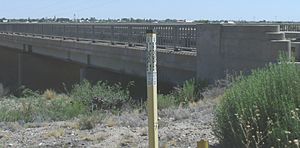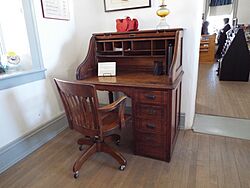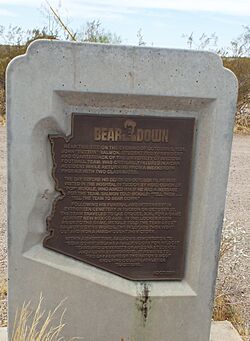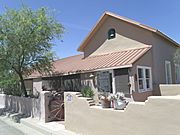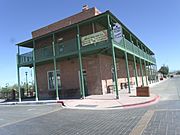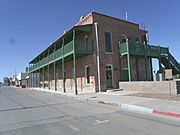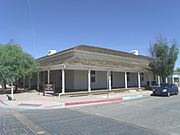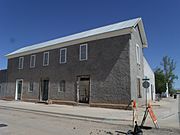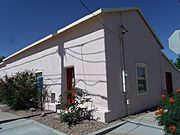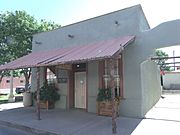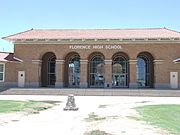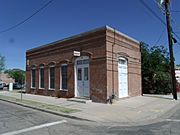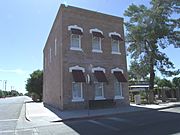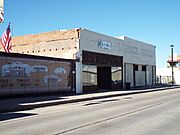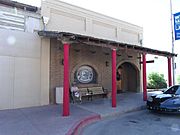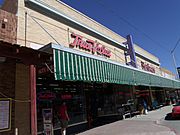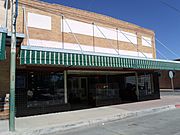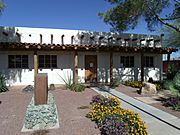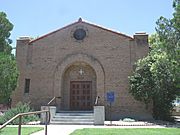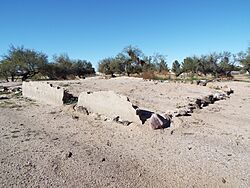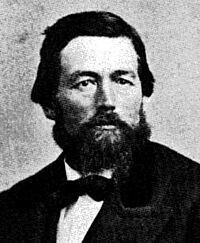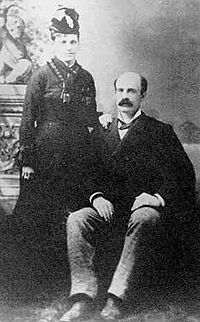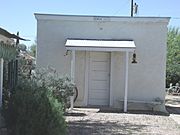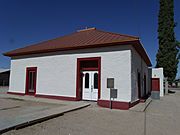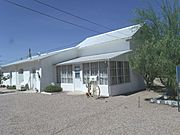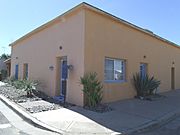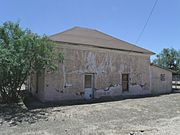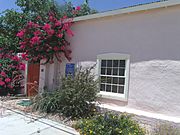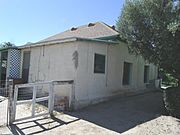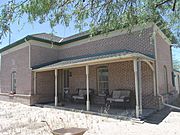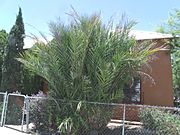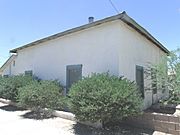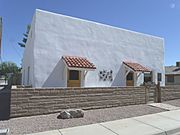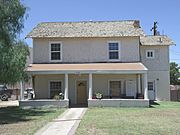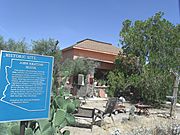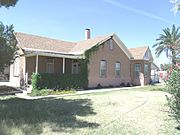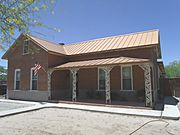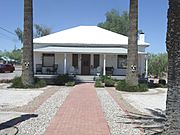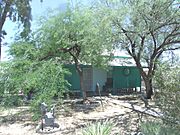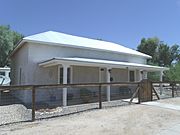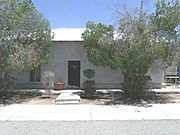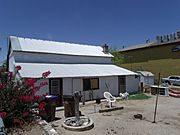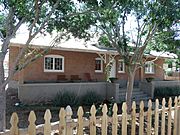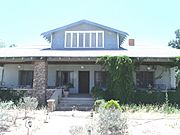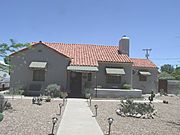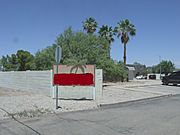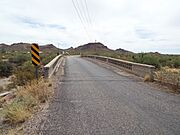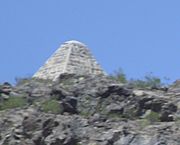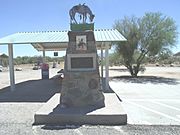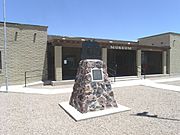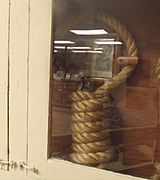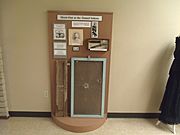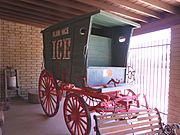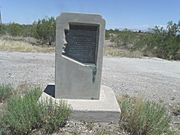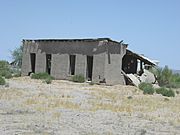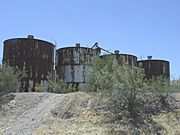List of historic properties in Florence, Arizona facts for kids
Quick facts for kids
List of historic properties
in Florence, Arizona |
|
|---|---|
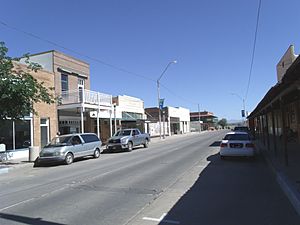
Main Street of the original town-site of Florence. The town-site was listed in the National Register of Historic Places on October 26, 1982, reference #82001623.
|
|
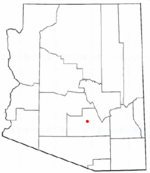
Location in Pinal County and the state of Arizona
|
This article shares information about the many historic places in Florence, Arizona. You'll find pictures of old buildings and monuments that tell the story of the town. It also includes photos of places that were once part of Adamsville, a small farming town that was destroyed by a flood in 1900. Adamsville is now considered a ghost town and is part of Florence. Important landmarks like Poston Butte and the Tom Mix Monument are also featured.
Contents
Florence's Story
Florence was started by Levi Ruggles, a veteran of the American Civil War. He founded the town on the southern edge of the Gila River. Florence is about sixty-one miles southeast of Phoenix. It's located in Pinal County, Arizona, United States. Florence is the main town, or county seat, of Pinal County. It's one of the oldest towns there. It's even recognized as a National Historic District. More than 25 buildings in Florence are listed on the National Register of Historic Places. This means they are very important to the history of the country.
The Florence Historic District Advisory Commission helps decide which properties are historically important. If a property is chosen, it can be nominated for the National Register of Historic Places. However, even if a building is historic, local rules don't stop owners from tearing it down. This means some historic buildings might be lost forever.
Florence also had a POW camp during World War II. POW stands for "Prisoner of War." These were soldiers captured during wartime. The first prisoners arrived in May 1943. They were Italian soldiers. German prisoners came later. After the war, the camp was used as a low-security prison and then a hospital. It closed in 1966. Today, nothing is left of the camp. But some items left by the prisoners are on display at the First Pinal County Courthouse museum.
Pictures of the remaining structures of Adamsville, a ghost town, are also included. Fred Adams founded Adamsville in 1870. It was a farming town with stores, homes, a post office, a flour mill, and water tanks. In 1900, the Gila River flooded and destroyed most of the town. The people who survived moved to Florence.
You'll also see historical items displayed at the Pinal County Historical Society and Museum. These items show the early history of Florence. Some are even connected to people who were held at Florence's Arizona State Prison. Among the monuments shown are the pyramid-shaped tomb of Charles Debrille Poston, known as the "Father of Arizona." There's also the Tom Mix Monument, marking where the famous silent film star died.
The Florence Bridge
The historic Florence Bridge was first built in 1885. It crosses the Gila River. It was rebuilt in 1909. This makes it the third oldest bridge from the Arizona Territory still in use today. J.B. Girand, Arizona's first engineer, designed the bridge. The Gila River used to be part of the border between the U.S. and Mexico. This changed in 1853 with the Gadsden Purchase. That agreement moved the U.S. border further south. The U.S. Department of the Interior says the Florence Bridge is one of the most important river crossings in Arizona. It is eligible to be listed in the National Register of Historic Places.
Endangered Properties
The Arizona Preservation Foundation works to find important historical sites that are at risk. In 2012, they listed these properties in Florence as endangered:
- The Adamsville Ruins.
- J. N. Denier Tenement House.
Historic Properties
Buildings
Here is a short description of some historic buildings in Florence:
- The E.N. Fish and Co. Store Building – Built in 1867 at 420 Quartz St. This was Florence's first store, opened in 1868. It's recognized as historic.
- The Second E.N. Fish and Co. Building – Built in 1874 at 520 Main St. This store helped Florence become an important farming trade center. It also offered hotel rooms and a saloon. It's recognized as historic.
- The Charles Rapp Saloon Building – Built in 1875 at 361 Main Street. This building was known for its "Elegant Club & Reading Room." It's recognized as historic.
- The Silver King Hotel – Built in 1876 at 24 W. 6th St. This hotel was built for William Long, a partner in the Silver King Mine. It's recognized as historic.
- The First Pinal County Courthouse – Built in 1876 at W. 24 Ruggle St. Levi Ruggles designed and built this adobe building in 1878. It was a courthouse, then a hospital, and now a museum. It's listed on the National Register of Historic Places.
- The Jean Baptiste Residence/ Lone Star Store – Built in 1878 at 220 Ruggles Street. Jean Baptiste was a farmer from France. It's recognized as historic.
- The John Nicolas's New Beer Hall – Built in 1880 at 180 Bailey Street. This building was also used as a newspaper office. It's recognized as historic.
- The Jean Avenenti Building – Built in 1886 at 289 Main Street. Italian immigrant Juan Avenenti built this for his meat market. It's recognized as historic.
- Florence High School – Built in 1887 at 1000 S. Main St. This school is listed on the National Register of Historic Places.
- The John Nicolas Saloon – Built in 1889 at 46 E. 11th St. This is the oldest standing brick building in Florence. It's recognized as historic.
- The Conrad Brunenkant City Bakery Building – Built in 1890 at 291 Bailey St. This two-story brick building was for a Dutch-born baker. It's recognized as historic.
- The Gentry's Florence Market building – Built in 1890 at 368 Main Street. A smaller part was added in 1917.
- The Second Pinal County Courthouse – Built in 1891 at 135 Pinal St. This courthouse is a very important building in Florence. It was designed by James M. Creighton. It's listed on the National Register of Historic Places.
- La Paloma Bar – Built in 1912 at 255 Main St. It was a saloon and later a pool hall. It's recognized as historic.
- The White and McCarthy Lumber and Hardware Building – Built in 1914 at 290 Main St. It's recognized as historic.
- The Popular Store/ Mandells Dept. Store Building – Built in 1915 at 291 Main St. This store sold ready-to-wear clothing. It's recognized as historic.
- The Mauk Building – Built in 1925 at 360 Main St. This building was part of an early movie theater. It's recognized as historic.
- The Florence Women's Club Building – Built in 1929 at 231 Willow St. It's recognized as historic.
- The Florence Town Hall Building – Built in 1948 at 130 Main St. This building also served as a police and fire station. It's recognized as historic.
Houses of Religious Worship
These places of worship are recognized as historic by the Florence Historic District Advisory Commission:
- The Chapel of the Gila – Built in 1870 at 306 E. 8th St.
- The Second Catholic Church – Built in 1912 at 221 E. 8th St.
- The First Presbyterian Church of Florence – Built in 1931 at 225 Butte Ave.
- Historic Houses of religious worship
(National Register of Historic Places )
(Florence Historic District Advisory Commission.)
Houses
Here are some historic houses in Florence. Many are listed on the National Register of Historic Places. Some famous people lived in these homes. These include Pauline Cushman, an American actress and spy during the American Civil War. Also, Richard E. Sloan, Arizona's last Territorial Governor. And Thomas Fulbright, a lawyer who wrote a book about his experiences.
- The Ruins of Levi Ruggles House – Built in 1866. The ruins are on Ruggles St. Levi Ruggles, who founded Florence, built this home. He was a Civil War veteran. It's recognized as historic.
- The Granville Wheat Outback House – Built in 1871 at 125 Ruggles St. It's recognized as historic.
- The Elena Llescas House – Built in 1872 at 175 Bailey St. It's recognized as historic.
- The James S. Melquides E. Douglas House – Built in 1874 at 850 S. Park St. It's listed on the National Register of Historic Places.
- The Jesus Martinez House – Built in 1875 at 321 Bailey St. This house was once used as the first County Hospital. It's recognized as historic.
- The Ross/ Fryer-Cushman House – Built in 1876 at 364 N. Grant St. Pauline Cushman, a famous spy, later bought this house. Tom Mix also lived here for a time. It's recognized as historic.
- The Walker-Oury House – Built in 1877 at 255 Ruggles St. This building was used for court and county offices. It was later bought by Granville Henderson Oury, an important political figure. It's recognized as historic.
- The John Clum House – Built in 1878 at 180 N. Granite St. This home was built by John Clum, who started Florence's first newspaper. He was also Tombstone's first mayor. It's recognized as historic.
- The Isabelle Cosgrove House – Built in 1878 at 191 Bailey St. Frank Cosgrove, a blacksmith, lived here with his wife Isabelle. It's recognized as historic.
- The James S. Melquides E. Douglas House – Built in 1874 at 850 S. Park St. It was listed in the National Register of Historic Places in 2004.
- The George Brown House – Built in 1878 at 125 Ruggles St. George A. Brown, Florence's first Wells Fargo agent, lived here. It's recognized as historic.
- The Jesus Preciado de Luna/ Bernardina Lorona House – Built in 1880 at 115 E. 11th St. It's recognized as historic.
- The Fields House – Built in the 1880s at 423 9th St. It's listed on the National Register of Historic Places.
- The John Nicolas Residence – Built in 1880 next to the "John Nicola New Beer Saloon" at 180 Bailey St. It's recognized as historic.
- The Sam Kee House – Built in 1880 at 171 Pinal St. Sam Kee was a Chinese immigrant who lived in Florence. It's recognized as historic.
- The Harvey-Niemeyer House – Built in 1880 at 250 S. Main St. Dr. William Harvey, a physician, lived here. It's listed on the National Register of Historic Places.
- The Emma Monk Guild House – Built in 1880 at 171 Willow St. Emma Monk Guild was a teacher and principal. She is known as one of Arizona's "mothers of education." It's recognized as historic.
- The Elmer Coker House – Built in 1881 at 100 S. Main St. Elmer Coker helped create the Arizona Corporation Commission. It's recognized as historic.
- The William Clark House – Built in 1884 at 190 Main St. This house was later home to Richard E. Sloan, Arizona's last Territorial Governor. It's recognized as historic.
- The Andronico Lorona House – Built in 1886 at 324 Silver St. It's listed on the National Register of Historic Places.
- The Carmen Mecha House – Built in 1887 at 240 Ruggles St. It's recognized as historic.
- The Truman Randall House – Built in 1887 at 550 S. Main St. W.C. Truman was a sheriff. It's listed on the National Register of Historic Places.
- The Jacob Suter House – Built in 1888 at 270 Pinal St. Jacob Suter was a tinsmith from Switzerland. It's recognized as historic.
- The John Keating House – Built in 1888 at 234 Willow St. John Keating was a pioneer stage driver and mayor of Florence. It's recognized as historic.
- The Albert T. Colton/ H. H. Freeman House – Built in 1889 at the corner of Butte and Willow Streets. It's listed on the National Register of Historic Places.
- The C.D. Henry House – Built in 1889 at 144 S. Willow St. This is one of the oldest brick homes in Florence. It's listed on the National Register of Historic Places.
- The W.Y. Price House – Built in 1900 at 1612 Willow St. It's listed on the National Register of Historic Places.
- The Ines and Davis Littlefield Bea House – Built in 1900 at 1913 S. Elizabeth St. It's listed on the National Register of Historic Places.
- The George Brockway House a.k.a. the Araiza House – Built in 1900 at 501 S. Central Ave. George Brockway was Florence's first mayor. It's listed on the National Register of Historic Places.
- The Carminatte-Parham House – Built in 1910 at 350 E. 6th St. It's listed on the National Register of Historic Places.
- The Ignacio Manjares House – Built in 1910 at 351 Silver St. Ignacio Manjares was a founding member of a cattle growers group. It's listed on the National Register of Historic Places.
- The Adrian Pierson House – Built in 1912 at E. 6th St. and U.S. Route 79. It's listed on the National Register of Historic Places.
- The Joseph Spinas Rental House – Built in 1913 at 221 Bailey St. Joseph Spinas was a cattle rancher who helped build early irrigation ditches. It's recognized as historic.
- The George Huffman House – Built in 1919 at 425 Butte Ave. It's listed on the National Register of Historic Places.
- The Thomas Fulbright House – Built in 1925 at 75 Matilda St. Thomas (Tom) Fulbright was a lawyer involved in important cases. It's listed on the National Register of Historic Places.
- The John Zellinger House – Built in 1929 at 191 Willow St. It's recognized as historic.
- 9th, Willow and Central Street – This is the area where Levi Ruggles was buried in 1889. His second house was here. Sadly, his family's gravestones are now gone, and an apartment complex was built over the site.
- Historic Houses in Florence, Arizona
(National Register of Historic Places )
(Florence Historic District Advisory Commission.)
Bridges
- The historic Florence Bridge – This bridge was first built in 1885 over the Gila River. It was rebuilt in 1909. It is the third oldest bridge from the Arizona Territory still in use.
- The Queen Creek Bridge – Built in 1916. It's on the Old Florence Highway over Queen Creek. It's listed on the National Register of Historic Places.
- Historic bridges
-
Bridge in Florence, Az. over the Gila River.
Monuments and Memorials
This section shows pictures of important monuments and memorials:
- The entrance of the historic Florence Cemetery on Salazar Road.
- The tombstone of Josephus "Joe" Phy, also in the Florence Cemetery. Joe Phy died in a famous event at the Tunnel Saloon in 1888. His tombstone reads:
- The "Pyramid Tomb" of Charles Debrille Poston. He is known as The Father of Arizona because he worked hard to create the Arizona Territory. He was also Arizona Territory's first representative in the U.S. House. His tomb is on Primrose Hill, now called Poston Butte.
- The Tom Mix Monument. This monument is on Arizona highway 79, about 20 miles from Florence. It marks the spot where Tom Mix, a huge silent film star, died in 1940. The monument reads:
In Memory of Tom Mix
Whose spirit left his body on this spot, and whose characterization and portrayals in life served to better fix memories of the Old West in the minds of living men
-
The Pyramid Tomb of Charles Debrille Poston, known as The Father of Arizona.
Pinal County Historic Society & Museum
The Pinal County Museum started in 1959. The building it's in now was built in 1970. It has exhibits about early Native-American tools and daily life for pioneers in Florence. It also has items related to the prison.
- Pinal County Historic Society & Museum
Adamsville Ghost Town
Adamsville was a farming town started in 1870 by Fred Adams. It had stores, homes, a post office, a flour mill, and water tanks. In 1900, the Gila River flooded and destroyed most of the town. People who survived moved to Florence. A marker there says: "In the 1870s, a flour mill and a few stores formed the hub of life in Adamsville, where shootings and knifings were commonplace, and life was one of the cheapest commodities. Most of the adobe houses have been washed away by the flooding Gila River." Adamsville is listed on the National Register of Historic Places.
- Adamsville Ghost Town
(National Register of Historic Places )
See also



